
 |
 |
 |
 |
 |
 |
 |
email: roadarch@outlook.com |
 |
| Coral Castle |
(hit "refresh" to get the most recent version of this page; click on photos for larger images)
 |
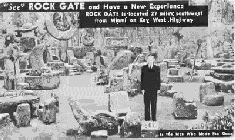 |
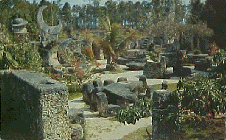 |
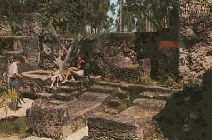 |
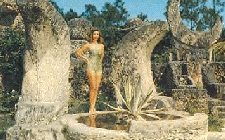 |
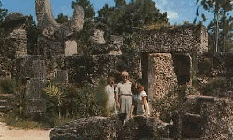 |
| The Florida Table surrounded by Coral Rocking Chairs | |
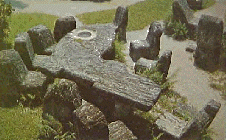 |
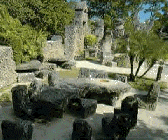 |
| The Heart Table | The Tower | The Gate |
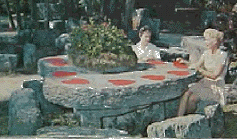 |
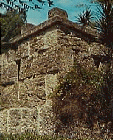 |
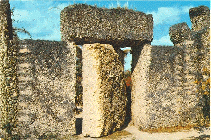 |
| The Moon Pond | Moon, Mars & Saturn | Obelisk & BBQ |
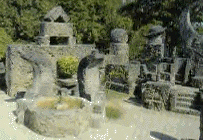 |
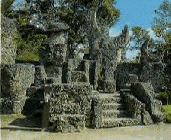 |
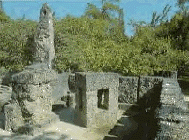 |
| Photos from 2005: | ||
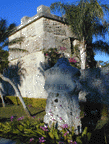 |
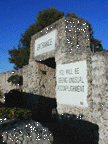 |
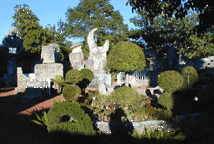 |
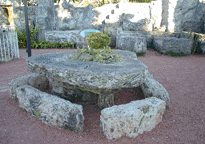 |
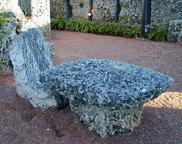 |
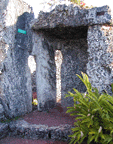 |
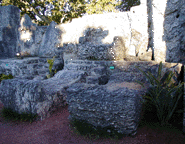 |
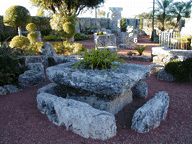 |
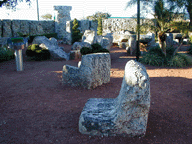 |
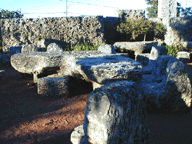 |
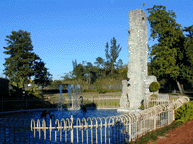 |
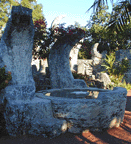 |
 |
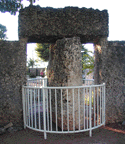 |
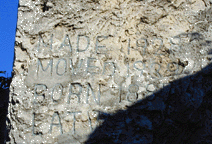 |
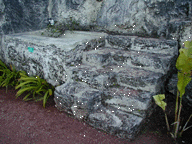 |
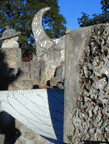 |
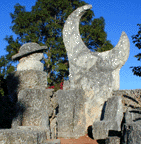 |
 |
|
Born in Latvia, Edward Leedskalnin (1886-1951) came to the U.S. in 1920 after being jilted by his 16 year old fiancee. (He first moved to Western Europe, Canada, Washington State and finally, Homestead, FL.) This rejection became his life’s obsession and he began building in her honor with grey coral rock for the next 20 years. His "Sweet Sixteen" monument was an attempt to woo back his sweetheart. It is composed of roofless rooms with twin beds, rocking chairs, a nursery (for his would be family) and a table shaped like Florida with a washbasin shaped like Lake Okeechobee. There are 10 acres of outdoor space with a rock garden, a 28-ton obelisk and a telescope. He called his place “Rock Gate Park” after the 9-ton door that is so well balanced that it swings open at the slightest touch.
The real mystery of the place is how a middle-aged, five foot tall man, weighing about 100 pounds, moved the enormous coral blocks. He worked alone and exclusively at night so no one would know how he carved the coral or managed to move the blocks weighing over 25 tons. These blocks were heavier than those used to build Egypt's Great Pyramid and taller than those used in Stonehenge. Over a 20 year period, he quarried and sculpted over 1,100 tons of coral rock using mostly tools he made from junkyard auto parts. All this despite the equivalent of a 4th grade education! Leedskalnin attributed his compulsive building to his obsession with Agnes Skuvst (throughout his life referred to as "Sweet Sixteen"). She jilted him on their wedding day and told him that at 26 he was too old and too poor for her. He fled to Canada and worked his way through California and Texas as a lumberjack and cowboy until he was told he had tuberculosis and was advised to seek a warmer climate. He arrived in Florida just after WWI and bought an acre in Florida City. He began to carve the coral rock he found under the thin Florida topsoil. He started with a chair, then a table, then an entire castle. His plan was that he would become so famous for the massive rock castle that Agnes would hear about it and come back to him. After 16 years of building, he decided to move everything 10 miles away because he said Florida City was getting too crowded and he wanted more privacy. He bought 10 acres in Homestead and single-handedly and secretively transported the castle piece by piece at night in less than a month, leaving just one tower behind. No one was permitted to watch him load or unload the truck on which he moved the blocks. Some folks theorize that he moved everything to Homestead to be closer to a center of telluric force. They believe that the original Florida City location was the result of mathematical error. Leedskalnin claimed he knew the secrets of magnetism which the ancient Egyptians used to build the pyramids. He disputed contemporary science and believed all matter consisted of magnets. He said he had “re-discovered the laws of weight, measurement, and leverage” and that these concepts “involved the relationship of the Earth to celestial alignments.” He spoke of seeing “beads of light” which he believed to be the physical presence of nature’s magnetism – what many today call “chi”. He boasted that he could “chase mosquitos away with this concentrated look.” Many think Leedskalnin had discovered the secret of levitation and used it to move the coral blocks. In fact, there is an account of teenagers who spied on him and reported that he floated coral blocks “through the air like hydrogen balloons.” The 9-ton swinging gate is thought by many to be over a vortex (energy sensitive people report headaches while standing inside the arch). Some believe that this area of South Florida is connected to the Bermuda Triangle (a powerful diamagnetic levitator). Celestial and mystical imagery abounds in his sculptures which are aligned with the moon and sun. A series of concentric coral circles is said to represent the solar system. There is an incredibly accurate sundial. The coral blocks fit together with amazing accuracy though constructed without cement. Several locations have six-pointed stars – some say it is the Latvian Star while others think it is the Star of David and that Ed may have fled Latvia to escape religious persecution. The park is essentially an open-air home surrounded by 8’ high coral black walls that he built in 1940 to ensure his privacy. Among the structures he built is an outdoor Throne Room with coral seats for him, Sweet Sixteen, a child and his mother-in-law (very uncomfortable). Not a single tool mark has been found on any of the chairs. (It is now often used for weddings.) He also built a bedroom for the children he hoped to have. It contains a rocking cradle, child’s rocker and 2 children’s beds. There is a Repentance Corner where a child’s head would be held for an hour or so. A taller opening was meant for his wife should she disobey him. There is also a playground based on Goldilocks and the 3 Bears. The Tower is the only enclosed structure. It contains a small, 2-story living quarters (which no one was ever allowed to enter) and tool shed. Inside were found a leather hammock and a crude table with hand tools, tools on walls, oil lamps and a well for fresh water; a bedroom with 2 twin beds, an outdoor cookery and bathroom. There was no plumbing or electricity. Here he would spend his days reading books on magnetic currents and cosmic forces. He also wrote and self-published a manifesto called “A Book in Every Home” in 1936. Leedskalnin only napped for a few hours in late afternoons and subsisted on sardines, crackers, eggs and milk. He trapped an occasional rabbit and produced some vegetables and fruit. The Park was opened to the public in 1923 – just a few years after the building began. But Leedskalnin only let people in when he felt like it. The dimes charged for the tours helped with his minimal expenses. He passed away in 1951 (at age 64) of malnutrition and kidney failure (another source says stomach cancer). In 1980, Agnes Skuvst was found (at age 83) and invited to see Coral Castle. She refused to go saying she didn’t want to marry him then and didn’t want to know about him now. The place remains very much as it did in 1951 and is listed in the National Register of Historic Places. Today, the enormous Gate requires more of a shove than a finger to push it open. It is left permanently ajar to keep it from possibly crushing visitors although it still fits within a quarter inch on both sides. Hurricane Andrew left the Castle unscathed while everything around it was devastated. For more, see these websites: 1, 2, 3, 4, 5, 6, 7, 8, and 9. |
| Special Places Main Page |
| RoadsideArchitecture.com |
Copyright. All photos at this website are copyrighted and may only be used with my consent. This includes posting them at Facebook, Pinterest, blogs, other websites, personal use, etc. Tips & Updates. If you have suggestions about places that I haven't covered, historical info, or updates about places/things that have been remodeled or removed, I'd love to hear from you: roadarch@outlook.com. |